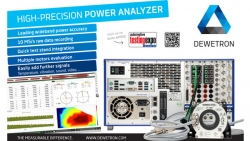Some of the New Products on Show
Real-time challenges for power
Dewetron
 The demand for so-called ‘real-time’ power analyzers for electrical powertrain testing has increased in recent years. Use cases include HIL testing and the development of advanced inverter control strategies. The term ‘real-time’ is standardized and means that the computing system ensures the results are available within a specified timeframe.
The demand for so-called ‘real-time’ power analyzers for electrical powertrain testing has increased in recent years. Use cases include HIL testing and the development of advanced inverter control strategies. The term ‘real-time’ is standardized and means that the computing system ensures the results are available within a specified timeframe.
Transferring this definition to the practical use of power analyzers results
in the demand for a low I/O delay between the measurement signal input and the calculated data output to a testbed controller. The typical definition for a
real-time-capable system is an I/O latency <1ms but in the context of power analyzers a latency <10ms is normally accepted.
The challenge is that normal operating systems do not support such small latencies but can at best reach 200ms. Real-time-capable power analyzers are normally realized in two ways: computing the power values on the data acquisition board by using performant FPGAs, and using an operating system that provides a real-time kernel for the power calculation.
Dewetron follows the second approach and equips its real-time-capable power analyzers with a real-time operating system and a real-time power application software. The Dewetron solution outputs its data with a typical delay of 2ms (max. 4ms) via ethernet UDP or EtherCAT. No dedicated real-time data acquisition hardware is required, with the additional benefit that existing power analyzers can be easily upgraded via software.
The real-time power analyzer is not the only innovation from Dewetron. A new power analyzer for EOL and production testbeds is under development, as well as a current input that will futureproof power analyzers for upcoming challenges in inverter design.
Booth 8332
